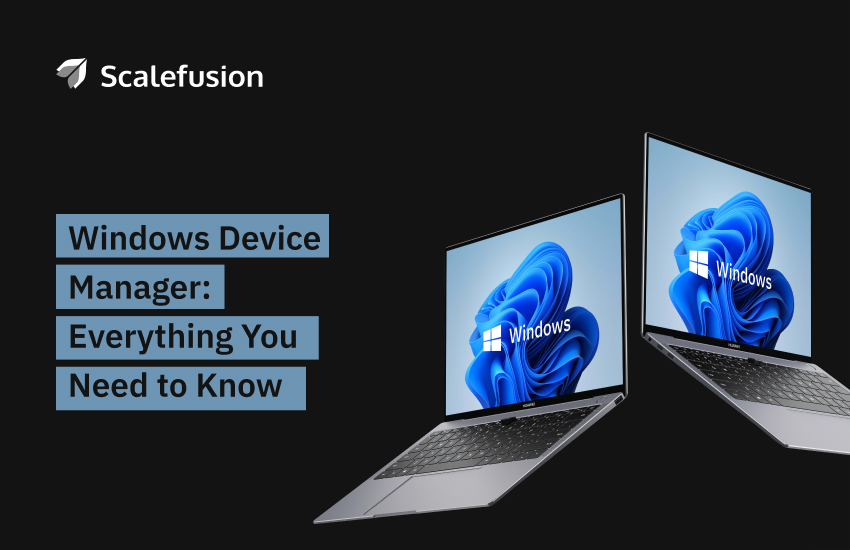Windows Device Manager is a small but useful using for Windows device management. It is a Windows operating system component and was first introduced in Windows 95. The purpose of the Device Manager is elementary—manage all the hardware on a computer that Windows knows of. Updating hardware device drivers is one of its main tasks.

This vendible explores how the Device Manager plays an important role in Windows device management.
What is Windows Device Manager?
Device Manager is a Tenancy Panel applet in Microsoft Windows that you can use to view and tenancy the hardware unfluctuating to the computer. It manages all hardware devices installed on a computer, such as nonflexible drives, sound cards, USB devices, keyboards, mouses, and so on.
The Device Manager allows you to –
- Change hardware configuration options; enable/disable hardware
- Retrieve and install device drivers
- Identify any discord between hardware devices
- View the property of each hardware device
Why is Windows Device Manager Important?
Troubleshoot Devices – Device Manager helps troubleshoot devices when they malfunction. In unrepealable versions of Windows OS, when there is a problem with any of the devices, a yellow exclamation mark indicates that Windows has identified an error. If you are not sure how to resolve it, locate the error lawmaking and follow the recommended resolutions for that error code. For example –
Code 29 – The device is disabled [1]
Full Error Message
This device is disabled considering the firmware of the device did not requite it the required resources. (Code 29)
Recommended Resolution
Enable the device in the BIOS of the device. For information well-nigh how to make this change, see the hardware documentation or contact your computer’s manufacturer.
Update Drivers – Device drivers are essential software that helps hardware components work smoothly on your system. A computer with a hardware issue probably has a driver-related problem. Regular suburbanite updates fix security and compatibility issues, mend wrenched code, and plane add features to hardware.
Device Manager can squint for updated drivers for hardware that connects to the Windows palmtop or computer. Once it scans for updates, new drivers will be downloaded and installed automatically. In Windows 10 and 11, will-less updating is the default and easiest method to trammels for suburbanite updates and installation. Unrepealable device drivers may require a reboot to well-constructed the installation.
Set Privacy Settings – Privacy settings are a way of executive how organizations can handle personal information online. Companies can use Device Manager to turn off devices to limit the sharing of personal information. For example, hardware such as cameras and palmtop microphones need drivers to function, which can be disabled with the Device Manager.
How to Use Windows Device Manager
Opening Device Manager
In any version of Windows, Device Manager can be opened using the writ prompt with its run writ “devmgmt.msc”. To launch the Device Manager, printing the Windows R keys to unshut a Run dialog box. Type the writ and printing Enter.
Alternatively, you can right-click the Windows Start sawed-off on the taskbar and then click Device Manager. On Windows 10 laptops or computers, simply type ‘Device Manager’ and select from the menu. You will see a list of installed hardware.
Viewing the Status of a Device
You can click on the devices to trammels for any issues. For example, In Windows 10, you may see a yellow exclamation mark versus the hardware. It indicates that the system has encountered a problem with that particular piece of hardware.
A woebegone thunderstroke next to a device ways that the hardware is disabled. It could be considering the device was disabled manually or Windows hasn’t allocated any system resources to be used by the hardware.
If the operating system cannot talk with the hardware device, follow these steps:
- Note the error code
- Device manager may suggest a solution. Try the suggestion
- Share the lawmaking with the palmtop manufacturer
- Some hardware devices have a ‘Check for Solutions’ sawed-off that lets you submit a Windows Error Report to Microsoft
Windows Device Manager is Great, But…
In a merchantry environment, the Device Manager plays a limited role. For instance, if employees cannot use their laptops considering of a disabled or external driver, they may take it upon themselves to fix the issue by downloading and installing unsanctioned software.
Several download sites offer files pretending to be the drivers which host malware. Other sites stow drivers with adware. They try to trick users into installing unwanted software to proceeds wangle to the system and unfluctuating networks.
If unchecked, unmanaged laptops and computers are a high-security risk for large organizations. Adopting a mobile device management (MDM) solution helps IT restrict the installation of unsanctioned drivers. With MDM, IT admins can wield policies and controls on installing unauthorized software on thousands of devices.
Wrapping Up
To know how you can effortlessly manage your Windows devices, get a self-ruling 14-day trial.
References:
